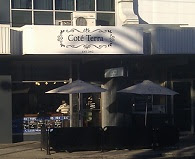Designer
|
Hans Wright
|
Maker
|
Colourware
Pottery
|
Marks
|
Incised
“Colourware Pottery” to base
|
Material
|
Glazed slip
lustre glaze
|
Description
|
Shallow rounded bowl angled inwards at top. Unglazed footring with lustre glaze to
outside and spoon handle angled upwards form centre of bowl body. Matte cream glaze to interior. Banded brown glaze to exterior. Slight overspray of lustre glaze to interior
rim of bowl.
|
Condition
|
Very good
|
Number
|
No number
|
Production
Date
|
Late 1980s
|
Width at rim
|
110mm
|
Width at Base
|
70mm
|
Depth
|
50mm
|
Length (with
handle)
|
165mm
|
Weight
|
220gm
|
Volume
|
375ml
|
Acquisition
|
Salvo stores
Brandon Park 29th May 2013.
|
Rameking
Reference Number
|
COL 001-002
|
Colourware Pottery seems to be a brief continuation
of Hanstan. Hanstan Studio Pty Ltd
ceased as a company on the 8th of January 1988. Like “Diana” producing later versions (Dana) and Nefertiti, or someone from
Southern Aurora, Hanstan, or a person associated with the works, continued with
the production of a limited range of pottery.
This lustreware came in a small variety of patterns from ashtrays to
kitchen canisters. “Lustre” is an
effect produced by a second (reduction) firing of the body with a metallic
oxide glaze (bismuth oxide) in a slightly cooler kiln. This gives the product a metallic gold,
silver or bronze appearance. The
design, size and shape of these ramekins is identical to those made by Hanstan,
only the glaze and signature are different.
Hanstan were mostly made on Victoria's Mornington
Peninsula,in the 1960s to the early 90s. I have been told that their
pottery was located at Mornington in the Industrial area. Starting in
1962, most of their considerable output was domestic or kitchenware so they
don't appear on the radar of most of the trendy wanker collectors. Have a look
in any op shop and there is sure to be at least one piece.
Hanstan output was originally
mostly marked with a large incised signature "Hanstan" to the base. Other
later works had either a black stamp or a black and gold sticker. These were
used after Hanstan moved from hand painting to transfer designs. These are incised “Colourware Pottery” in a
similar script.
Hanstan on the left, Colourware Pottery to the right
Hanstan refers to Hans Wright and Stan Burrage. The partnership
apparently didn’t last long as I was told the two had a falling out in the
early sixties with Hans and Mrs Wright continuing the pottery. Hans Earle Wright was a salesman turned
potter turned archer. He was born in the mid 1930s and completed an art course
at the Melbourne Technical College, now RMIT. He started out helping a fellow
student make jewellery. He married Patricia, a nurse and then moved from
Sandringham to Mount Eliza.
Hans had more than one string to his bow, being Australia's best
archer, he won about fifteen Australian Championships. Hans would train archers
in the factory, believing that the noise of the pottery would make the archers
less likely to be distracted in competition. Good for the archers but somewhat
off putting for the potters. There is no record of anyone being hit by an
arrow. I wonder what the Health and Safety people today would make of this. Mrs
Wright would manage the pottery when Hans went off to the many archery
competitions he took part in.
For two years from age 19 to 21 well known former graffiti artist
Arjuna Watson worked at Hanstan Pottery Studio, hand-painting floral
Christopher Vine designs. (Afterwards he makes himself a promise: “I will never
paint an iris again”.) Christopher vine would come to the pottery whenever he
came up with new lines. Thanks AJ for the info. If anyone has more information
about this pottery, I would be pleased to hear from you. I know you are still
out there Hans.
The Stan was Stanley Leonard Scud Burrage who was born in Robinvale
Victoria on the 7thof December 1935 and was christened at Traralgon,
Victoria one year later. Like Hans, he originally worked in sales but together
they began Hanstan pottery at his parents, George and Elsie (Weymouth) Burrage’
home and poultry farm on Springvale road, Springvale, Victoria in 1962.
The partnership dissolved in 1964 and Hans then continued the business
in Mornington, Stan and wife Helen went overseas for two years then they
moved to the bayside suburb of Mentone, where they ran a hardware shop in
Hampton for two years. then back to Vinifera near Swan Hill to be an
Orchardist betweenn 1972 to 75. Later, in the early 1980s, Stan worked as
a contractor in Dingley, Victoria. Stan died too young at the age of 52
in Montrose Victoria on the 1st of March 1987
The Wrights lived in Mount Eliza and worked in the neighbouring town
of Mornington. Hans is reputed to have been a bit of a workaholic. The pottery
was run as a fully commercial operation, producing mainly domestic wares.
Staff served a form of "apprenticeship" doing routine process work
before graduating to more involved work. Starting in the sanding booth,
cleaning up the bodies from the moulds before moving on to glazing, then if you
were good enough, or had lasted the distance, decorating.






